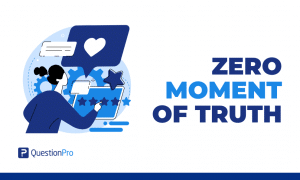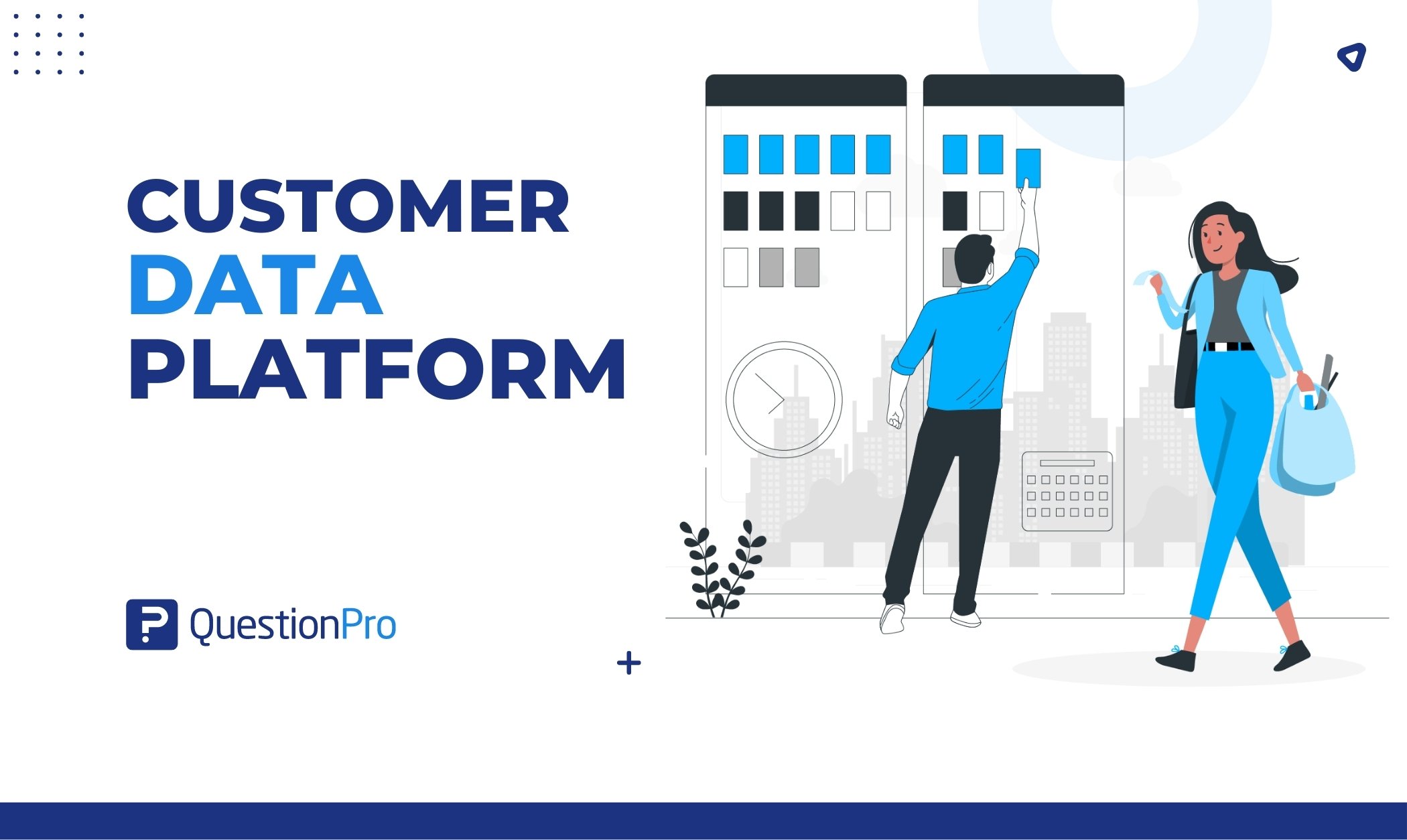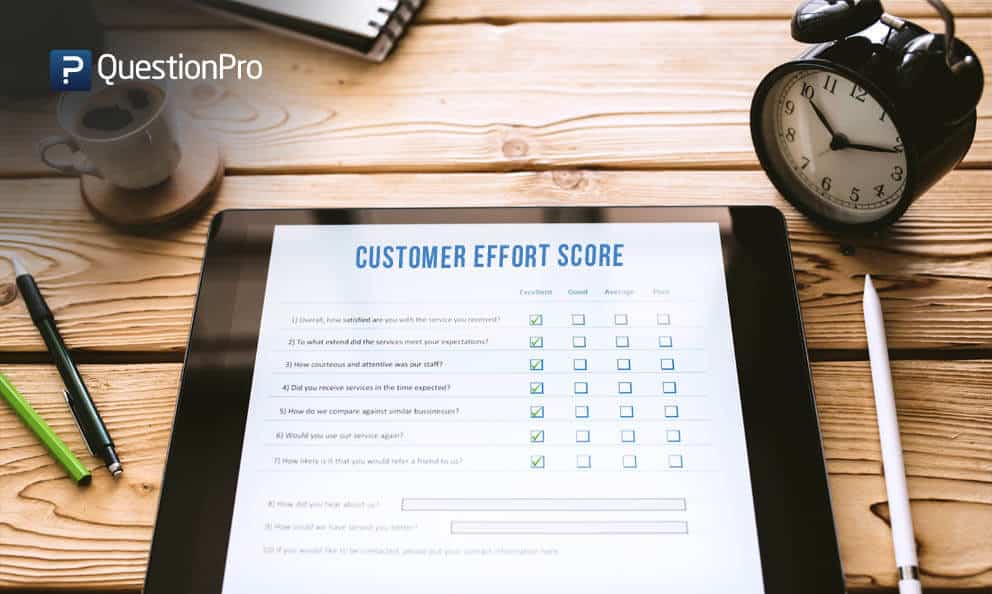
The Customer Effort Score (CES) metric measures how much effort customers put forth in dealing with a company. It gives information about how easy or difficult customers engage with enterprises, assisting companies in understanding and raising customer satisfaction.
A higher CES doesn’t indicate a satisfied customer and can’t accurately let you know your customer’s loyalty. Customer Effort Score surveys are a customer feedback metric system that measures the ease of interaction instead of the satisfaction rate. Learn how to use CES scores to build an overall better customer experience, starting with a lower effort for your customers.
What is Customer Effort Score (CES)?
Customer Effort Score (CES) is a type of customer satisfaction survey used to measure the ease of service experience with an organization. It asks customers to rate the ease of using products or services on a scale of “very difficult” or “very easy.”
CES was originated by the Corporate Executive Board using a simple, cross-sectional research approach without the benefit of actual measures of customer behavior in the research model. An extensive review of their findings can be found in their book, The Effortless Experience.
The research focused on factors affecting customer attitudes in a customer service environment, particularly with some problems to be addressed. The level of high-effort service interaction the customer had to expend proved to be the key factor determining a customer’s likelihood of shopping with or recommending a business in the future.
The research found that while high customer effort increases the probability of customer disloyalty, low effort doesn’t drive customer loyalty. In other words, a customer will likely avoid shopping at your business or recommending it to friends if they have to work hard to solve a problem. However, if the customer’s needs are anticipated and met with low effort on their part, this doesn’t guarantee they’ll continue to use your business.
When Is the Right Time to Send a CES Survey?
The Customer Effort Score (CES) survey is intended to assess the ease with which a customer interacts with a firm. It focuses on determining how much effort a customer spends to complete a task or remedy a problem. Here are some examples of when a CES survey is appropriate:
After a customer support interaction
If a customer just talked to your customer support team to solve a problem or get help, sending a CES survey right after the conversation can give you important information about how well and how easy the support was.
After a purchase or transaction
After a customer buys something or finishes a transaction, you can send them a CES survey to find out how they felt about the process. This can include judging how easy it is to find and choose products, find your way through the checkout process, and take any other steps needed to finish the transaction.
After a self-service experience
If your business has self-service options like an online knowledge base, a list of frequently asked questions (FAQs), or chatbots, you can send a CES survey to customers who have used these tools. This will help you figure out if the self-service tools worked to answer their questions or resolve their problems with the least amount of work.
After onboarding or account setup
If you offer services that require customers to set up an account or go through an onboarding process, sending a CES survey soon after this step can help you evaluate how easy the setup process was and find any pain points or places to improve.
After a website or app interaction
If a customer has used your website or mobile app to do something like fill out a form, change their account settings, or look at goods, you can send them a CES survey to find out how easy it was for them.
After a service appointment or delivery
Sending a CES survey after an appointment or delivery can help businesses figure out how easy and convenient the whole process is, from setting up the appointment or delivery to communicating with the customer and completing the task.
Don’t forget that the timing of the CES survey is very important. Sending it soon after the relevant contact with the customer makes sure that the experience is still fresh in the customer’s mind, which makes it more likely that they will give accurate and useful answers. But don’t send too many surveys to customers at once because that can make them tired of taking surveys and lower their answer rates.
Importance of Customer Effort Score (CES) Surveys
Gartner said that reducing customer effort was significant for reducing disloyalty. Understanding what the customer is trying to do is important if you want to give them an effective and efficient experience. As a result, conversion retention and customer trust go up. Customer Effort Score (CES) surveys are important because they:
- Measure customer effort: CES surveys measure how much effort work customers must do when connecting with a business.
- Predict customer behavior: High customer effort is often linked to dissatisfaction and possible customer churn, making CES a useful predictor of how customers will act.
- Identify pain points: CES surveys help pinpoint specific areas where customers encounter difficulties, enabling businesses to prioritize improvements and enhance the overall customer experience.
- Guide improvement efforts: CES feedback provides actionable data for targeted enhancements, streamlining processes, and eliminating sources of frustration.
- Differentiate from competitors: Delivering a low-effort experience sets a business apart and creates loyal customers who appreciate the convenience and simplicity of interactions.
- Engage and empower employees: Involving employees in CES initiatives fosters a sense of ownership and empowers them to contribute to enhancing the customer experience.
CES surveys help businesses understand customer effort, predict behavior, address pain points, guide improvements, differentiate from competitors, and engage employees to deliver exceptional customer experiences.
Example of Customer Effort Score
The CES metric is gaining traction as many businesses seek to understand their customers better. Use this Customer Effort Score question example to see how CES works and how you can use CES to help determine customer satisfaction.
Customer Effort Score question example:
This question example uses the Customer Effort Score 5-Point scale to determine the ease of doing business. The 5-point scale uses extreme positive, positive, neutral, negative, and extreme negative answer options to gather data from customers. Customers choose a positive, neutral, or negative effort reaction to doing business with you.

Customer Effort Score formula:
The Customer Effort Score calculation requires you to determine the percentage of positive (very easy and easy) and negative (very difficult and difficult) responses to your CES survey. You can then subtract the number of negative responses from the positive responses.

How to use a Customer Effort Score(CES)
Evaluate the feedback you receive for a Customer Effort Score survey. If your organization has a high average, it is indicative that your company is making the experience convenient for customers. A low average indicates there’s room for improvement to make the customer experience easier.
An organization that is experiencing poor customer satisfaction can use the Customer Effort Score to evaluate problem areas in the company. After discovering where your customers have to put forth the most effort, you can begin remedying these areas to decrease customer effort. This should help increase customer satisfaction over time. Remember, however, that decreasing customer effort doesn’t always mean an increase in customer loyalty. Instead, customers expect most businesses to provide services that require little effort.
The Kano Model from the Japanese quality guru explains this relationship. Some expected deliverables, like low customer effort, drive satisfaction. Other factors, such as quality products, drive delight and loyalty to your brand.
Customer Effort Score should be one of the survey types implemented after every customer transaction with your organization. The use of the CES survey is transactional following customer interaction.
Advantages and Disadvantages of Customer Effort Score (CES)
Advantages:
- It’s better at predicting brand loyalty and repurchases and is less volatile than other customer satisfaction metrics. Although CES isn’t an exact measurement of customer satisfaction, you can draw conclusions from ease of interaction to satisfaction.
- This scoring model applies to all client-facing processes, which makes it extremely easy to take corrective actions throughout your organization.
- It’s a highly reliable method to predict customer behavior and satisfaction.
Disadvantages:
- This scoring model is limited to service in particular and not your overall business.
- It only gives results of whether customers find it difficult to use a service or not. You can’t determine what exactly was difficult or why a process was difficult.
- The impact of factors like your cost, competitors, or product quality is not taken into consideration.
Customer Effort Score vs. Net Promoter Score
Customer Effort Score (CES) and Net Promoter Score (NPS) are correlative surveys with their own set of advantages and disadvantages. The Customer Effort and Net Promoter Score calculate customer loyalty and satisfaction.
However, there are certain situations where NPS is more effective than CES and where CES is a better indicator. They both ask different sets of questions that are more or less complementary to one another.
NPS depicts the likelihood of recommendation – “How likely are you to recommend Company X to a friend or colleague?” It is usually used to analyze brand shareability and loyalty. NPS fails to evaluate customer behavior for their latest interaction with the organization. This is where CES calculation can help.
Customer Effort Score asks customers to rate the difficulty they faced with the organization’s services. The more you reduce the difficulty, the better it will be for brand loyalty. High difficulty levels indicate changing how you operate and prioritizing customer satisfaction.
“Competition is always a good thing. It forces us to do our best. A monopoly renders people complacent and satisfied with mediocrity.” Nancy Pearcey
Going by this quote and popular belief, the more relevant method to measure the strength of your score is by using your competitor’s score as a benchmark. This is a better method to measure your NPS or CES metric because this considers your industry.
Airlines, for example, bring more direct experiences to customers than banks. They tend to have higher CES and NPS ratings. It wouldn’t be helpful to compare a department store to an insurance company, as the customer experiences and needs are entirely different.
How to use CES and NPS together
NPS is popular because of its simplicity in analyzing two major aspects of business: customer satisfaction, loyalty, and anticipated business evolution. Promoters tend to stay committed to an organization and are also great sources of free marketing through recommendations to family and friends. A promoter is loyal to your organization, but it’s important to remember that they’re not guaranteed to stay loyal if your customer experience falls short.
NPS measures the overall feel of a customer towards your business and can’t be used to measure a specific customer service experience. CES, on the other hand, measures the ease of solving customer issues. It can be extremely effective in understanding obstacles in the customer experience, thus allowing you to eliminate these obstacles and indirectly increase customer loyalty.
Looking to start a survey? Check out these free customer satisfaction survey templates
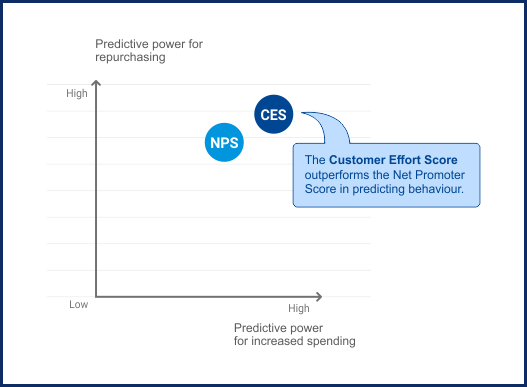
Customer Effort Score Benchmark
All successful companies are constantly benchmarking their competition. They have to know what they have to match up with day in and day out if their company is going to be successful.
-James Dunn
According to research done by CEB Global, the overall benchmarks of CES 2.0 is below:
Learn in detail: Customer Effort Score Benchmarking.
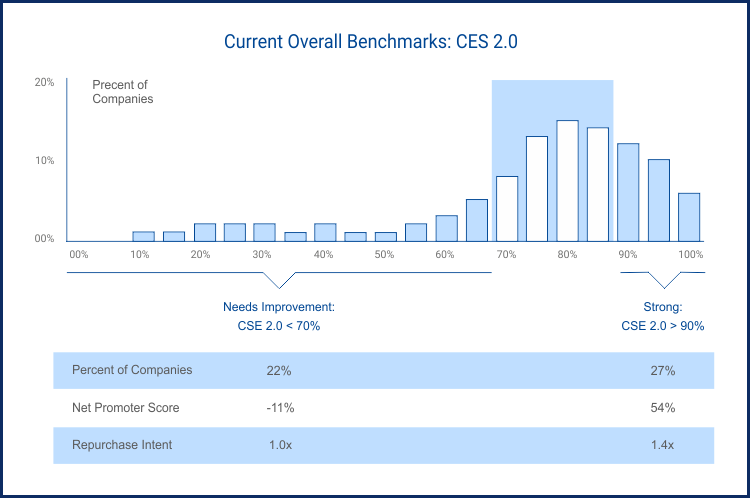
If your CES percentage is under 70%, you may want to focus on pinpointing and removing obstacles your customers face.
Using the competitive landscape as your benchmark
“Competition is always a good thing. It forces us to do our best. A monopoly renders people complacent and satisfied with mediocrity.” Nancy Pearcey
Going by this quote and popular belief, the more relevant method to measure your score’s strength is using your competitor’s score as a benchmark. This is a better method to measure your NPS or CES metric because this considers your industry.
Airlines, for example, bring more direct experiences to customers than banks. They tend to have higher CES and NPS ratings. It wouldn’t be helpful to compare a department store to an insurance company, as the customer experiences and needs are entirely different.
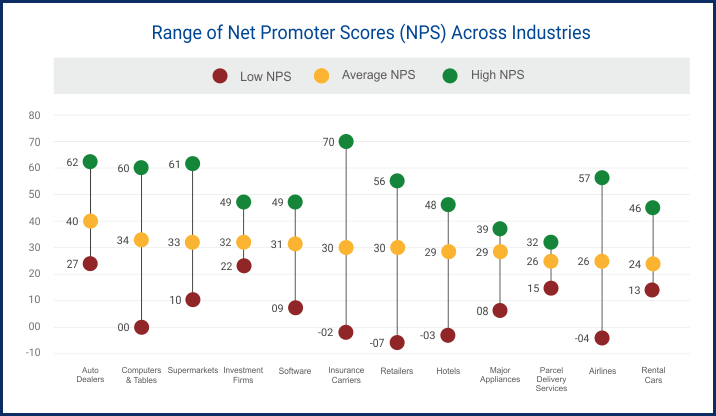
The Airline industry has a typical NPS range from -4 to +57. United Airlines has an NPS of 10, ranking as one of the worst companies in the airline space.
Global standards vs. Competitor benchmarking
It is critical to note that scores will vary across geographic markets. If you have ever compared NPS in the US and Europe, you probably know the cultural and demographic differences when rating a company’s performance.
For example, European customers are more conservative with rating a company’s performance. Consider the Customer Effort Score question example, such as, “On a scale of 1-10, with 10 being the least difficult, how easy was your transaction today?” European respondents are unlikely to give a 9 or 10 in any situation. In other regions, you may find customers using the lower end and higher end of the scale but skipping in between. Because of these differences, the absolute Net Promoter scores in one industry can vary dramatically.
Comparing your metric against your own
Since your metric is nothing but a vanity number on its own, it is impossible to give you a single number that represents a good Customer Effort Score, especially when you are starting out. The best way to find out if your number is “good” is to compare it with your most important benchmark – your previous scores.
The best way to start measuring progress would be to compare your Customer Effort Score calculation against your score over the last quarter or six months. If you are noticing an increase of at least 10%, you are heading in the right direction and progressing toward building a successful business driven by organic growth.
On the other hand, if you notice a significant decrease in CES, this indicates that your customer experience is getting more difficult. You should work quickly to identify the cause and take appropriate measures to address the issue.
It’s better to focus on what drives your score rather than the number itself. Remember, a good Net Promoter Score or Customer Effort Score by itself is not a quantifiable metric to grow. Your main goal should always be to listen, analyze, and act on your customer feedback.
Learn more about QuestionPro CX
Conclusion
Customer Effort Score (CES) is a useful way for businesses to measure and improve customer happiness. CES helps find areas of trouble and ways to make things better by measuring how easy or hard it is for customers to work with a company.
By focusing on making it easier for customers, businesses can improve the total customer experience, increase customer loyalty, and make their operations run more smoothly.
Companies can reduce the amount of work customers must do and be successful in the long run by streamlining processes, improving self-service options, and optimizing help channels. CES is a very effective way to make people happier and build strong relationships with them.
At QuestionPro, we work on what we believe in. Schedule a demo with Ken and discover how to boost customer loyalty and collect valuable consumer insights through our consumer survey and analytics management platform.





